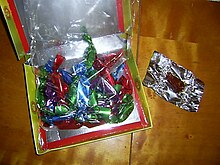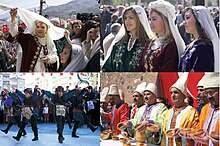This article needs additional citations for verification. (December 2015) |
Mesir Macunu (Turkish pronunciation: [mesiɾ̥ maːd͡ʒunʊ]) is a traditional Turkish sweet associated with the city of Manisa. Earlier versions of Mesir macunu were not sweet, but rather spicy in flavor.[1]
 | |
| Type | Sweet |
|---|---|
| Place of origin | Manisa, Turkey |
| Associated cuisine | Turkish |
| Main ingredients | Toffee paste |
| Mesir Macunu Festival | |
|---|---|
 2010 Mesir Macunu Festival in Manisa, Turkey | |
| Country | Turkey |
| Reference | 00642 |
| Region | Europe and North America |
| Inscription history | |
| Inscription | 2012 (7th session) |
| List | Representative |
Macun is a sweet Turkish confectionery toffee paste that originated from spicy preparations of Mesir macunu.[1][2]
Herbs and spices used
editBelow is a list of spices and herbs used in making the Mesir Paste, along with their Turkish and Latin names:
- Allspice (Yeni bahar) (Pimenta dioica)
- Alpina officinarum root (Havlıcan kökü) (Alpina officinarium)
- Anise (Anason) (Anisum vulgare)
- Black cumin (Çörek otu) (Nigella sativa)
- Black Myrobalan (Kara halile) (Terminalia nigra)
- Black pepper (Karabiber) (Piper nigrum)
- Buckthorn (Topalak or Akdiken) (Nerprun alaterne)
- Cardamon (Kakule) (Elettaria cardamomum)
- Cassia (Hiyarsenbe) (Cassia)
- Chebulic myrobalan (Kara halile) (Terminalia chebula)
- China root (Cop-i cini) (Smilax china)
- Cinnamon (Tarçın) (Cinnamomum verum)
- Cloves (Karanfil) (Syzygium aromaticum)
- Coconut (Hindistan cevizi) (Cocos nucifera)
- Coriander (Kişniş) (Coriandum sativum)
- Cubeb (Kebabe) (Cubebae fructus)
- Cumin (Kimyon) (Cuminum cyminum)
- Dried orange blossom (Portakal çiçeği)
- Fennel (Rezene) (Foeniculum vulgare)
- Galingale (Havlıcan) (Alpinia officinarum)
- Ginger (Zencefil) (Zingibar officinalis)
- Iksir sugar (Iksir şekeri)
- India blossom (Hindistan çiceği)
- Java Pepper (Kuyruklu biber) (Piper cubeba)
- Licorice extract (Meyan balı) (Glycyrrhiza uralensis fisch)
- Licorice root (Meyan kökü) (Glycyrrhiza glabra)
- Mastic (Çam sakızı) (Mastichum)
- Millet (Hintdarisi) (Pennisetum glaucum)
- Myrrh (Murrusafi) (Commiphora Molmol)
- Muskroot (Sümbül) (Adoxa moschatellina)
- Mustard seed (Hardal tohumu) (Brassica nigra)
- Orange peel (Portakal kabugu)
- Rhubarb (Ravend) (Rheum Palmatum)
- Saffron (Safran) (Crocus Orientalis)
- Citric acid (Limon tuzu)
- Senna (Sinameki) (Cassia senna)
- Turmeric (Zerdeçal) (Curcuma domestica)
- Udulkahr (Udulkahir)
- Vanilla (Vanilya) (Vanilla planifolia)
- Woad (Çivit) (Isatis)
- Yellow myrobalan (Sarı halile) (Fructus myrobalani)
See also
editReferences
edit- ^ a b "The Turkish sweet tooth". DailySabah. November 24, 2014. Retrieved December 27, 2015.
- ^ Isin, M. (2013). Sherbet and Spice: The Complete Story of Turkish Sweets and Desserts. I. B. Tauris. pp. 86–90. ISBN 978-1-84885-898-5.